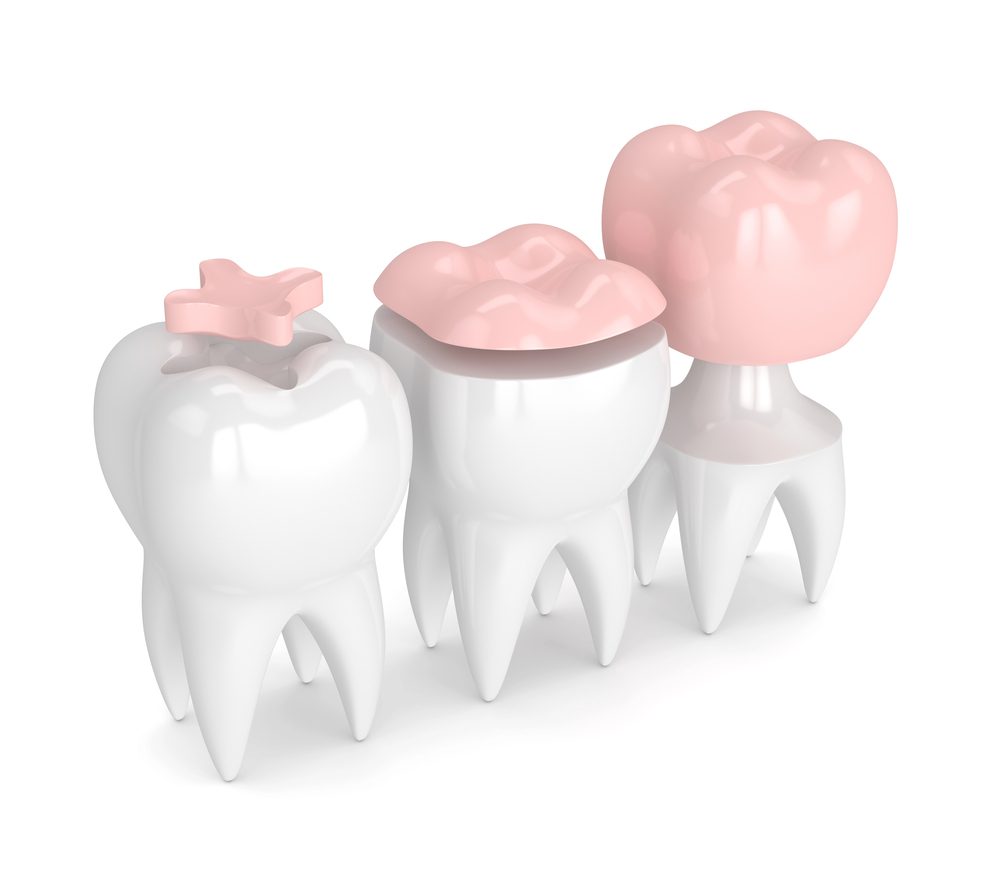Inlays and Onlays:
The Conservative Alternative to Crowns
When you have a cavity or damaged tooth that’s too large for a regular filling but not damaged enough to need a full crown, inlays and onlays offer the perfect middle-ground solution. These custom restorations preserve more of your natural tooth while providing excellent durability and a natural appearance.

What Are Inlays and Onlays?
Think of inlays and onlays as custom-made puzzle pieces that fit precisely into or onto your tooth. They’re crafted in a dental laboratory from tooth-colored materials and then permanently bonded to your tooth.
Inlays fit within the cusps (bumps) of your tooth, similar to a filling but much stronger.
Onlays cover one or more cusps of your tooth, providing more coverage and protection.
Both preserve more of your natural tooth structure than a crown while providing better durability than a large filling.
When Might You Need Inlays or Onlays?
We typically recommend them when:
- You have a large cavity that’s too big for a regular filling
- An old filling has failed and needs replacement
- You have a cracked or fractured tooth that doesn’t need a full crown
- You want to replace old metal fillings with tooth-colored restorations
- You need maximum strength but want to preserve tooth structure
They’re especially good for back teeth that do a lot of heavy chewing work.
Are You a Good Candidate?
Inlays and onlays work well for people who:
- Have a damaged tooth that’s too big for a filling but doesn’t need a crown
- Want to preserve as much natural tooth structure as possible
- Have good oral hygiene habits
- Want a long-lasting, natural-looking restoration
We might suggest waiting if you have:
- Have very extensive damage (a crown might be better)
- Have active decay that needs to be addressed first
- Grind your teeth severely (we’d want to discuss protection)
- Have a very small cavity (a regular filling would be sufficient)
Inlays/Onlays vs. Other Options
Compared to large fillings:
- Much stronger and longer-lasting
- Better fit (no shrinkage during placement)
- Less likely to cause cracks in your tooth
Compared to crowns:
- Preserve more natural tooth structure
- Less expensive
- Often require less tooth preparation
Compared to old metal fillings:
- Look completely natural
- Don’t expand and contract with temperature changes
- No mercury concerns
The Inlay/Onlay Process
This typically takes two appointments:
First Visit (Preparation):
- We remove the old filling or decay
- Shape the tooth to accommodate the inlay or onlay
- Take precise impressions of your tooth
- Place a temporary restoration to protect your tooth
Laboratory Phase (1-2 weeks):
Your custom inlay or onlay is crafted from high-quality materials to match your natural teeth.
Second Visit (Placement):
- Remove the temporary restoration
- Check the fit and appearance of your new restoration
- Make any minor adjustments needed
- Permanently bond it to your tooth
Materials: What Are They Made Of?
Porcelain:
- Most natural appearance
- Excellent stain resistance
- Very durable
Composite resin:
- Good appearance
- Less expensive option
- Can be repaired if needed
We’ll help you choose the material that’s best for your specific tooth and situation.
What to Expect After Treatment
Your tooth should feel natural right away.
You might experience some mild sensitivity for a few days, which is completely normal.
Eating:
You can eat normally, though we recommend avoiding very hard foods for the first 24 hours while the bonding reaches full strength.
Care:
Treat your inlay or onlay exactly like your natural teeth – brush, floss, and come in for regular check-ups.
How Long Do They Last?
Inlays and onlays typically last 10-20 years or more with proper care, which is significantly longer than large fillings.
Factors that affect longevity:
- Your oral hygiene habits
- Whether you grind your teeth
- The size and location of the restoration
- Regular dental check-ups
Cost and Value
Inlays and onlays typically cost more than fillings but less than crowns, usually ranging from $600-$1,200 per tooth.
Many insurance plans cover inlays and onlays when they’re needed for functional reasons, often at the same rate as crowns.
The value proposition is excellent:
- Last much longer than large fillings
- Preserve more tooth structure than crowns
- Look completely natural
- Prevent future problems better than large fillings
Common Questions About Inlays & Onlays
The Best of Both Worlds
Inlays and onlays offer the durability you need with the conservation of tooth structure you want. They’re an excellent option when you need more than a filling but don’t want to lose the tooth structure required for a crown.
Let’s examine your tooth and discuss whether an inlay or onlay would be the best solution for your situation.